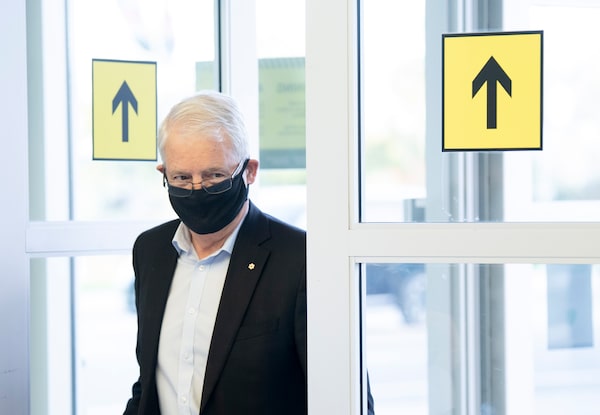
Minister of Transport Minister Marc Garneau arrives for the first day of a Liberal cabinet retreat in Ottawa on Sept. 14, 2020.Adrian Wyld/The Canadian Press
Transport Minister Marc Garneau says the federal government is coming close to making a decision on whether to green-light a proposed overhaul of Via Rail’s passenger rail service between Toronto and Quebec City.
“I’m hoping we’re going to be able to make a decision on that in the coming months," he told The Globe and Mail on Sunday. “We’re at the point now of coming close to making some fundamental decisions about high-frequency rail."
Mr. Garneau added the decision depends on cabinet approval and costs, which he declined to share, but said: “I will tell you personally I hope we can do it” in time for the spring budget.
Come on, ride the train: Why Canada needs a national rail strategy
Ottawa orders trains carrying dangerous goods to reduce speed after fiery crash in Saskatchewan
Via Rail for years has pushed for a modernization of the passenger rail system, with its efforts including a $989-million order for new trains in 2018. Under Via’s proposal, trains would run on dedicated tracks between major centres in the corridor that encompasses Canada’s two most populous cities and the capitals of Canada, Ontario and Quebec.
New routes would be established on discontinued and lower-density rail infrastructure; that would get Via trains off busy freight lines, increasing capacity to move people and goods and avoiding delays.
While the plan does not call for high-speed trains, which are common in Europe, Via Rail has said it would allow for more frequent trains, speeds of up to 177 kilometres an hour, shorter trip times and better on-time performance. Cost estimates for the project range from $4-billion to $6-billion.
The plan got a boost in June, 2019, with the creation of a joint project office between the Canada Infrastructure Bank and Via Rail, including $71-million in funding for an 18- to 24-month “preprocurement phase” to do environmental assessments and consult with First Nations along the proposed 850-kilometre route. Government officials, including Mr. Garneau, have insisted the work is not just another study but a serious plan that represented a critical phase prior to approval for construction.
Conservative transport critic Stephanie Kusie said the Liberal government “has had a terrible record” of completing infrastructure projects. “If they are looking into something I think that’s great,” Ms. Kusie said. “I hope it’s with the intent that they will complete a project that they begin.
"... But they also have to make sure that they are prioritizing transit projects properly. There are many areas, in the Greater Toronto Area, in particular, where they are still starving for transit solutions, and projects have not been completed and needs have not been met as of yet.”
Last December, Prime Minister Justin Trudeau asked Mr. Garneau to work with Infrastructure Minister Catherine McKenna “to create high-frequency rail” for the Toronto-Quebec City corridor.
But the pandemic has upended the government’s priorities and spending plans. Last week’s Throne Speech sought to re-establish the government’s mandate, and while it didn’t mention rail investments in particular, the government stated it will “invest in all types of infrastructure” in the next two years in an effort to create one million jobs.
Mr. Garneau said the high-frequency rail project “has been a very active file with us,” echoing testimony in June by Canada Infrastructure Bank chief investment officer John Casola to a parliamentary committee that planning efforts were making “tremendous progress.”
However, the country’s 40,000-kilometre rail system has faced challenges this year, including blockades by Indigenous groups before the pandemic. In addition, the number of cases of trespassing and tampering with railway lines, signalling systems and equipment doubled to 24 incidents a month in the period from April 1 through Aug. 21, compared with the same period a year earlier, Mr. Garneau said.
“I am extremely concerned … that one of these incidents is eventually going to lead to a very serious incident with potential loss of life or serious injury or a derailment that will involve dangerous goods," he warned.
Mr. Garneau said the government is partnering with Canadian Crime Stoppers, railway operators and law enforcement agencies with a goal of raising public awareness about the dangers of railway tampering and to encourage people to report suspicious incidents to authorities. He added the government is in the process of implementing 16 recommendations last year from a panel of experts to update the Railway Safety Act.
Ms. Kusie, the Conservative MP, said she was “not surprised that incidents are up” after the blockades early this year related to a dispute over a natural gas pipeline project running through Wet’suwet’en Nation territory in British Columbia.
“The message the government gave over the last 18 months has been: You can mess with our rail systems and there are no consequences. I’m glad to hear they’re taking some type of action. It sounds a little lame but at least it’s something positive in the right direction.”
Know what is happening in the halls of power with the day’s top political headlines and commentary as selected by Globe editors (subscribers only). Sign up today.
 Sean Silcoff
Sean Silcoff